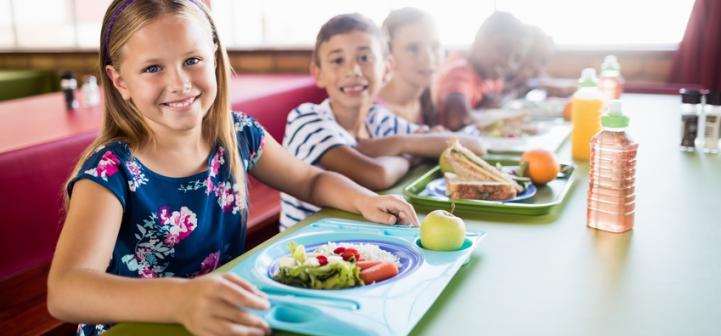Quantity, Quality, & Appeal – A Balancing Act
Historically, school food has gotten a bad rap for being unappetizing and even having poor nutritional value. If you haven’t been in a school cafeteria recently though, you may be surprised…
School meals are filling:
- School lunches are designed to meet 1/3 of the recommended daily allowance for calories. Portion sizes are largest for the oldest students and there is no limit on schools making second helpings of fruits or vegetables available.[1] Students have the option to select full servings of each of the meal components offered so they can fill up on a variety of foods.[2]
School meals are nutritious:
- Did you know kid’s favorites are now offered in healthier versions? Pizza is served on whole-grain crust with low-fat cheese and reduced sodium tomato sauce! The Healthy, Hunger Free Kids Act of 2010 enabled major improvements to school meals, bringing school meals in line with the latest nutrition science. By offering students familiar foods that are whole grain-rich, low in sodium and low in saturated fat, the school cafeteria is balancing nutrition and consumer demand.
- Parents can help kids get used to the taste of these reformulated foods by offering whole grain-rich foods at home like brown rice or whole wheat pizza crust, making fruits and vegetables available at every meal and snack, and cutting back on the salt whenever possible.[3] The longer these more rigorous nutrition standards are in place, the more students will get accustomed to new foods and be willing to eat them both at school and home.[4]
Students are NOT required to take things they aren’t going to eat:
- Critics of school lunch say that the required fruit and vegetable sides only feed the trash cans, not the students. However, students only need to select three out of five meal components offered including a ½ cup fruit OR ½ cup vegetable – although they can select all 5: fruit, vegetables, whole grains, protein-rich foods, and dairy. Schools are required to offer a variety of both fruits and veggies to appeal to all palates and to offer the most nutrition to students. Young children may prerfer canned fruits or baby carrots, while older students often readily select side salads, fresh fruits and vegetable medleys. Click here to read several tips that schools can use to increase fruit and vegetable consumption and decrease waste.[5]
School Meals are familiar & tasty:
- Schools purchase foods from the same companies that the neighborhood grocer purchases from – Tyson, General Mills, Kellogg’s, Dannon, Libby, Green Giant, etc. Milk can be purchased from a local dairy and produce from vendors that distribute to the local grocery store.
- While school programs often look for the best value, school food directors can select products based on a combination of price, quality, and geographic area.[6]
- Since the sodium level of school meals must be relatively low, school personnel often use other flavors and spices to enhance taste.[7] A nationally mandated nutritional analysis of school meals is calculated for an entire week’s worth of meals. So, if one day sodium is on the high side, food service staff can balance it with another meal that is a little lower in sodium another day of the week.
- Manufacturers have worked tirelessly in developing whole grain bread items that are flavorful and mild tasting. According to Liverpool Central School District’s Food Service Director Annette Marchbanks, “Most students don’t even realize that their pizza crust is a whole grain product and whole wheat bread items are now soft and flavorful. They have become very acceptable by the students.”
History
The National School Lunch Act was signed into law by President Harry Truman in 1946 to “safeguard the health and wellbeing of the Nation’s children and to encourage domestic consumption of nutritious agricultural commodities and other foods.”
- About 225 BILLION lunches have been served since the National School Lunch Act began in 1946! It has grown from approximately 7.1 million in 1947 to over 30 million in 2014.[8]
- In 2014, 100,000 schools participated in the National School Lunch Program, serving 30 million students! Of those students, 71% nation-wide qualified for free or reduced price meals. Read more here.
Funding
Many believe that school meals are funded by local school funds. School meal programs usually operate independently from the school budget. They are usually self-sustaining operations that receive funds through the US Department of Agriculture (USDA) and through the purchase of school meals. Schools participating in the National School Lunch Program also qualify for some additional government funding.
- Lunch money pays for much more than food. It has to cover all the operational expenses – labor, benefits, supplies, equipment, and sometimes utilities. Read more here.
- In 2010 the Healthy Hunger Free Kids Act was signed into law by President Obama. The act designated federal funds towards child nutrition programs and introduced more rigorous nutritional standards for school meals.[9]
- USDA donates surplus domestic foods to use in school meals, averaging out to about one serving for each lunch served.[10]
- Families with low incomes may qualify for free or reduced price meals. The USDA reimburses schools for these meals as long as they meet certain guidelines.
Contributors
Kathy Burrill, Chisago Lakes Area Schools
Annette Marchbanks, Liverpool Central School District
Shannon Klisch, UC CalFresh Nutrition Education Program, University of California Cooperative Extension in San Luis Obispo & Santa Barbara Counties
Chrissa Carlson, University of Maryland Extension
[4] http://www.rwjf.org/en/library/research/2014/07/student-reactions-during-the-first-year-of-updated-school-lunch-.html
[5] http://articles.extension.org/pages/73679/feature-series:-reducing-and-managing-school-cafeteria-food-waste

